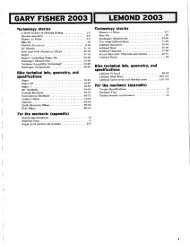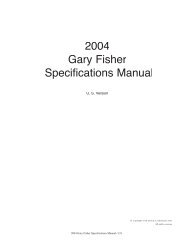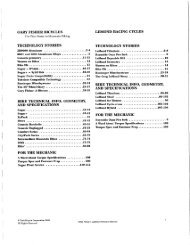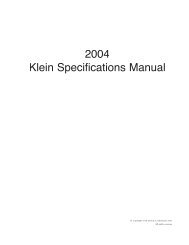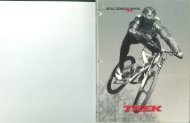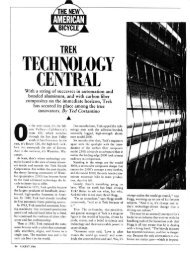TECHNOLOGY STORIES BIKE INFO, GEOMETRY ... - Vintage Trek
TECHNOLOGY STORIES BIKE INFO, GEOMETRY ... - Vintage Trek
TECHNOLOGY STORIES BIKE INFO, GEOMETRY ... - Vintage Trek
Create successful ePaper yourself
Turn your PDF publications into a flip-book with our unique Google optimized e-Paper software.
Tubeless Compatible technology allows the owner to choose between a conventional tire and inner tube, or a tubeless tire, including<br />
all current tubeless-type tires.<br />
Complete bicycles sold with Tubeless Compatible wheels normally have inner tubes installed in the tubeless tires. Tubeless tires<br />
‘bleed’ air faster than an inner tube, which over time may allow air loss. To keep the tires inflated longer, these bikes are equipped with<br />
tubes to protect their rims in shipping, and allow easy display. To convert these wheels to tubeless, see item #3.<br />
The key to the Tubeless Compatible system is a special rim and its mated rim strip. This rim strip is made of a thermoplastic<br />
rubber material, so its impervious to air. Installed correctly in the special mated rim, it seals tightly to prevent air escaping through<br />
the spoke holes.<br />
There are additional surfaces which must seal tightly for the tubeless system to hold air. The rim’s hook allows greater contact<br />
with the tubeless tire’s smooth, enlarged bead so these two surfaces also seal up tight. The inside of the tubeless tire has a special<br />
coating to prevent air from escaping through the tire casing. When these features are all in order, no tube is needed. Just install a<br />
special presta valve stem into the rim, and inflate.<br />
A properly mounted tubeless tire will ‘bleed’ air, up to 4 PSI (0.25 ATM) per day. If a tubeless tire loses air faster than 4 PSI<br />
(0.25 ATM) make sure the valve nut is tight, check for punctures, and make sure all sealing surfaces are clean. The sealing surfaces<br />
include the tire to rim contact, the tire to rim strip contact, and the rim strip to rim contact. Dirt, sand or other grime on any of<br />
these surfaces may allow extra air to escape.<br />
To inflate a newly installed tubeless tire, the tire must make full contact with the rim at the bottom of the rim well. To achieve this<br />
contact a tubeless tire has to fit on the rim more tightly than a similarly sized conventional tire.<br />
With a snug fitting tubeless tire, barehanded installation may be difficult. If you use tire levers for installation or removal, do<br />
not damage the rim or abrade the tire beads. If either surface is damaged, the roughened surface may allow a greater rate of air to<br />
bleed from the mounted tire.<br />
With the tire beads contacting the bottom of the rim well, air pressure is used to push the beads into their seated, sealed position<br />
against the rim hooks. A compressor is not required to seat the tire beads. A good floor pump or an air cartridge work, and a hand<br />
pump may work if nothing else is available.<br />
In the case of a punctured tubeless tire, you can patch a small (less than 3mm) hole from the inside of the<br />
tire. A sticky glueless patch is recommended. It the puncture is greater than 3mm, or the tire casing is damaged<br />
instead of merely punctured, with any broken threads, replace the tire. If the air leaks rapidly and the source is<br />
not immediately obvious, it may be difficult to inflate the tire enough to locate the puncture. However, its easy to<br />
convert from tubeless to the use of a standard inner tube.<br />
122<br />
Tubeless Compatible Installation and Troubleshooting<br />
1. INSTALLING AND INFLATING A TUBELESS TIRE<br />
Install the valve stem.<br />
1. Center the special rim strip in the rim. Make sure it fully covers all spoke holes.<br />
2. Align the base of the special tubeless valve with the rim (Fig. 41). Press the valve stem through the rim strip and rim<br />
until its seated firmly against the bottom of the rim well.<br />
3. Install the tubeless valve nut (Fig. 41) onto the the valve, and tighten firmly. There should be no gap between the<br />
valve and the rim strip.<br />
4. Inspect the rim strip. Make sure the rim strip lies centered in the rim well, with no wrinkles or unevenness.<br />
Again start opposite the valve and install the second tire bead. Move all the way around the rim until the second bead<br />
is completely in the rim well.<br />
Note: If you choose to use tools to mount the tire, be careful not to mar the rim or abrade the tire as this could reduce the required ability<br />
of the rim to seal to the special beads of a tubeless tire.<br />
2002 <strong>Trek</strong> Technical Manual<br />
Fig. 41<br />
Fig. 43<br />
Presta nut<br />
WARNING<br />
Make sure the rim strip covers all of the spoke holes or spoke heads. If they are exposed they may<br />
allow air loss, or puncture the inner tube, and may cause loss of control resulting in personal<br />
Install the tubeless tire.<br />
5. Lay one tire bead into the center of the rim well. Start opposite the valve to give the tire beads the maximum slack.<br />
If you start at the valve, the bead will lie on top of the valve. With the bead on top of the valve, some slack will be taken Fig. 42<br />
up which is needed to lift the tire bead over the rim shoulder (Fig. 42). Before proceeding to #6, move this first bead out<br />
of the rim well to make room for the second bead.<br />
If desired, the tire bead can be lubed with soapy water to aid in tire installation and seating of the bead.<br />
6.<br />
WARNING<br />
Do not attempt to use a standard tire without an inner tube. Such use may cause a rapid<br />
Bead lock<br />
deflation of the tire resulting in loss of control resulting in personal injury. If you are unsure if a<br />
tire is a compatible tubeless design, consult your dealer.<br />
Tubeless<br />
valve nut<br />
Too<br />
tight





